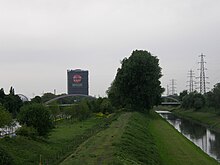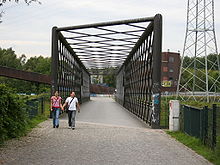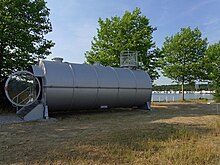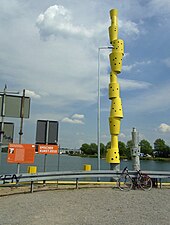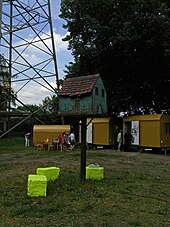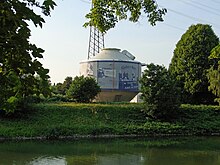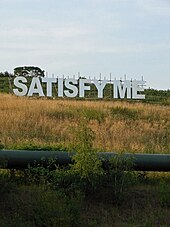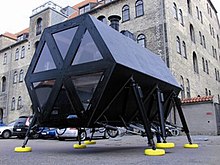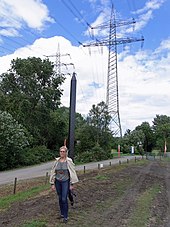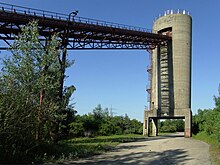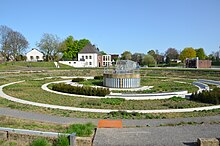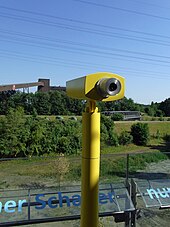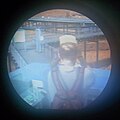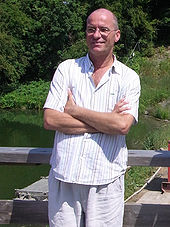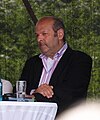Emscherkunst. 2010
Emscherkunst.2010 , its own spelling EMSCHERKUNST.2010 , was according to its own statement the largest art project in the public space of the European Capital of Culture RUHR.2010 . Under the direction of curator Florian Matzner and a project office, more than forty artists and students from the Münster Art Academy dealt with the realities of the region in the northern Ruhr area against the background of structural change.
Project
In the project, the participants worked on twenty works of various kinds, some in duos or groups, some of which can still be found in various, sometimes unusual places such as locks, in the canal or on industrial sites. The aim of the exhibition was to enable visitors to experience the space, which is characterized by a wide variety of uses. Art in public space with an urban focus, but also aspects of garden and landscape art, played a central role in the exhibition.
The exhibition venue is the Emscher Island , which is 34 kilometers wide between the Rhine-Herne Canal and the Emscher and is between 30 and 2000 meters wide and runs between Castrop-Rauxel and Oberhausen .
The Emscherkunst.2010 project was based on the conversion of the Emscher system initiated by the Emschergenossenschaft , an important prototype of cooperative regional planning and at the same time one of the largest renaturation projects in the world. In this concept, the island forms the core of the “New Emscher Valley”.
The works of art could be viewed from May 29, 2010 for 113 days. The works of art could be accessed by pedestrians, cyclists or by boat; for this purpose, several bicycle rental stations and a regular line service of the White Fleet were set up on the Rhine-Herne Canal between Oberhausen and Nordsternpark. The central point of contact for the exhibition was the visitor center in Gelsenkirchen's Nordsternpark . The glass exhibition pavilion is located on the roof of the Horst pumping station . This was redesigned for the 1997 Federal Horticultural Show based on a design by the artist Jürgen LIT Fischer .
The exhibition ended with a finissage on September 18, 2010. After the exhibition, some of the works of art from EMSCHERKUNST.2010 will be preserved and can still be visited. The permanent works of art include the garden art and light installation in BernePark in Bottrop-Ebel, the miners' mosaic on the digestion tower of the former sewage treatment plant in Herne, the obelisk made of carbon fiber reinforced plastic in Essen-Altenessen and the three-part sculpture reemrenreh in the Herne Sea . Furthermore, this includes the “Monument for a Forgotten Future” by Olaf Nicolai, Gordon Douglas with Mogwai, which was only inaugurated at the end of the exhibition, the observation tower by Tadashi Kawamata near the water cross in Castrop-Rauxel and the yellow telescopes by Jeppe Hein (in Share).
The bridge sculpture Slinky Springs to Fame in Oberhausen was only inaugurated on June 25, 2011. Mark Dion's bird observation station in the gas tank on the Herner Meer was stored in the Bottrop sewage treatment plant over the winter and exhibited from July 16 to September 11, 2011 in the Erlbruchpark behind the Recklinghausen town hall.
The exhibition is designed as a triennial. The next EMSCHERKUNST in 2013 will expand towards the western Ruhr area. Part of the Emscherinsel is once again an exhibition stage, and the cities of Duisburg and Dinslaken with the Emscher estuary are also included. In addition to the Emscher conversion, issues such as ecology and climate change will also play an important role in 2013. International and national artists, but also the regional art scene, will present their works from early summer 2013.
Showrooms
The works of art are presented in a total of eight exhibition rooms and with mobile and distributed installations.
Room 1 - Castrop-Rauxel: Emscher and Rhine-Herne Canal water cross
Walkway and Tower
On a hill near the Emscher culvert in the Recklinghausen area, the Japanese Tadashi Kawamata has built an observation tower, to which the visitor is guided via a wooden walkway about 120 meters long. The footbridge leads gently upwards through the landscape and provides new insights into the terrain, the climax of which is reached with the view from the tower platform.
Room 2 - "Herner Meer" with lock island
Society of amateur ornithologists
In Mark Dion's project, a large gas tank from the former Herne sewage treatment plant was converted into a walk-in “research station” where visitors can indulge in studying and observing local bird species. Inside the former gas tank, visitors can also expect the atmosphere of a “gentleman’s club”.
Reemrenreh (hardly any singing) and life
A large sculpture by the Düsseldorf artist Bogomir Ecker was created in front of the end of the “Herner Meer” pier, illuminated by a street lamp that was deliberately placed in the water. Based on the legendary Colossi of Memnon, the sculpture is made to sing through openings along its hollow body. Additional acoustics are created by the sound composition by Bülent Kullukcu, which accompanies the visitor to the sculpture on the 200-meter-long promenade.
Video with excerpt of the sound composition
Video with excerpt of the sound composition
Room 3 - Herne / Recklinghausen city harbor: Former Herne sewage treatment plant
The golden village - BASIS
In the Recklinghausen city harbor , a student project group from the Münster Art Academy has built a place to live and study, in which artistic works are developed and the entire exhibition is critically accompanied by workshops, lectures and discussions.
Glückauf. Miners' protests in the Ruhr area Protest chronicle
On the outer shell of the digestion tower of the former sewage treatment plant in Herne, a monumental wall mosaic by the Frankfurt artist Silke Wagner was created as a memorial to the history and decline of mining.
Breaking weather
Inside the same digestion tower, the artist duo M + M (Marc Weis and Martin de Mattia) presents a room installation with a film projection on a total of four screens, which describes the Ruhr area and its special economic and social situation using a family history.
Room 4 - Herne / Gelsenkirchen: Artists' mine "Our Fritz"
Satisfy Me
A monumental lettering by Monica Bonvicini with the exclamation "SATISFY ME" was created at the Emscherbruch landfill in Herne, far away from the viewer and inaccessible. The letters are made of smooth sheet metal, they reflect the sky behind the viewer. The letters are held in place by a steel frame that is part of the work of art.
5 - Gelsenkirchen: "Wild Island", Gelsenkirchen lock
Monument for a forgotten future
On the "Wild Island", an artificial hill in Gelsenkirchen, Olaf Nicolai designed an artificial rock that is modeled on a mountain formation from the Joshua Tree National Park in the USA. In addition, the Scottish rock band Mogwai, in cooperation with the Scottish video artist Douglas Gordon, is composing a song about the Emscher that will sound softly from the mountain. This “unnatural natural phenomenon” is intended to invite you to linger, climb and enjoy new views of the land between the Emscher and the Canal in the Capital of Culture year. This work was only finished at the end of Der Emscherkunst.2010 on September 18, 2010. The sound installation has been activated again since May 1, 2011.
The Rock and the Song of Mogwai
Walking house
During the duration of the exhibition, the energy self-sufficient “Walking House” of the artist group N 55 “runs” across the Emscher Island and is available to artists, writers and the local population as a place to live and work. The starting point for this is the Nordsternpark site .
Room 6 - Essen / Gelsenkirchen: Schwarzbach estuary, former Mathias Stinnes port
Waiting for the river
The Dutch group Observatorium, consisting of artists and landscape architects, is dedicated to the future of the renatured Emscher Valley with the sculpture “Waiting for the River”. The wooden construction of the bridge zigzags over a wild meadow, where the renatured Emscher is to run from 2020. On it there are three different pavilions as a bedroom, kitchen and sanitary room, which could be booked for an overnight stay while waiting. This is how private and public waiting meet. Waiting for the river is the built proposal to connect the private leisure domains with the century work of the Emscher conversion and forms a basis for a redesign of the landscape.
Carbon obelisk
Rita McBride's sculpture “Carbon Obelisk” is located at an inconspicuous crossroads north of the Emscher. The 14-meter-high obelisk is spatially in line with the landmarks the “Gate” ( Raimund Kummer ) and the “Bramme” by Richard Serra on the Schurenbachhalde and thus marks the continuation of the Emscherweg. The sculpture itself consists of a carbon fiber wrap bonded with epoxy resin , is deep black and hollow on the inside. In view of the high-tech material used, the sculpture ties in with the development of the region from the former center of coal mining in Germany to a progressive location for science and research.
Tower 79
Ayşe Erkmen's intervention relates to the former mountain bunker on the Schurenbachhalde on the south bank of the Rhine-Herne Canal, which can be clearly seen from the Emscher. For this, the artist covered the railing on the bunker with real gold, so that it seems as if a golden crown has been placed on the bunker. The title "Tower 79" also refers to gold - 79 is the atomic number for gold in the periodic table of the elements. Ayse Erkmen also plays with the designation of hard coal as the "black gold" of the Ruhr area.
Between the Waters - The Emscher Community Garden
In this garden-like art project made of ornamental and useful plants, the Emscher is symbolically linked to the Rhine-Herne Canal. This installation by Marjetica Potrč and Ooze Architects represents a biofilter system that transforms wastewater into service water and thus creates flowering areas for visitors.
Room 7 - Bottrop: BernePark
The overall planning for the redesign of the former sewage treatment plant at the mouth of the Bernese in Ebel lies with the Essen-based landscape architecture office Davids, Ter Frucht + Partner.
Garden art in the BernePark
As part of the redesign of the former sewage treatment plant into a public park, landscape artists Piet Oudolf and Eelco Hooftman from the London office Cross.Max are transforming one of the former clarifiers into a sunken garden that will be preserved as a water basin. The second clarification basin will be filled with earth and landscaped into a walk-in park. In addition, the former clarification basins are emphasized by the artist Mischa Kuball at dusk with a light installation that, like the circulating screens installed here earlier, regularly runs around the edges.
Catch as catch can
The clarification basins, which were transformed into works of art, were supplemented by a font installation by the New York artist Lawrence Weiner on the roof of the listed company building. The lettering is intended to break through the dreamy atmosphere of the future Bernepark.
Dasparkhotel
Based on an idea by the Austrian artist Andreas Strauss , five sleeping tubes that have been converted into overnight accommodation were laid out in the Bernepark. These are concrete tubes with a clear width of about two meters and a length of 2.60 meters with an artistically designed rear wall, a ventilation opening in it, a window hole about 30 centimeters in size and a door on the front that is locked and opened using an electronic combination lock can be. When booking an overnight stay, you will find out the opening code, which changes daily. The simple furnishings consist of a bed box, a slatted frame with a mattress topper, pillows, blankets and a bedside lamp. There are sanitary facilities in a container in the background. After the installation in Ottensheim, it is the second of its kind.
Room 8 - Oberhausen: Oberhausen Castle, gasometer
Slinky Springs to Fame
The new pedestrian and bicycle bridge at Oberhausen Castle , developed by Tobias Rehberger in close collaboration with the engineering office Schlaich, Bergermann und Partner , leads ten meters above the Rhine-Herne Canal and connects the Kaisergarten of Oberhausen Castle with the Emscher Island opposite. In order to reach the passage height, the entrances and exits wind themselves several times, so that the tension bridge reaches a total length of 406 meters.
Rehberger, who is seen as a border crosser between art, architecture and design, designed a swinging spiral - "light, wild, irregular, like a thrown rope". The name of the bridge sculpture was inspired by the toy Slinky . The tread is also rhythmically emphasized by fields alternating asymmetrically between 16 colors.
The flagship project of Emscherkunst.2010 represents around a third of the total costs. The bridge could not be completed for the opening at the end of May due to foundation problems; its inauguration took place in June 2011.
Cross-space art projects
Connecting Views
Spread over the entire Emscher Island, along the Emscher cycle and walking paths, telescopes by the Danish installation artist Jeppe Hein were placed in all eight exhibition rooms. At first glance, the telescopes are reminiscent of those on viewing platforms and tourist stop-off points, but they only meet the expected distant view in a figurative sense and surprise the viewer's perception habits through the images they see.
Connecting views at the Castrop-Rauxel water cross
3 puppet theater pieces for the Ruhr area
At a total of 80 different locations on the Emscher Island and in public places in the neighboring cities, three popular, crude puppet theater pieces by the Munich artist Stephan Huber were performed, which in the style of a traveling traveling circus from the 19th century, episodes from everyday life, but also from targeting the art system.
Participating artists
Florian Matzner is the curator of the exhibition.
- Monica Bonvicini (1965 in Venice, lives in Berlin and Los Angeles)
- Mark Dion (1961 in New York, lives there and in Beach Lake)
- Bogomir Ecker (1950 in Maribor, lives in Düsseldorf)
- Ayşe Erkmen (1949 in Istanbul, lives there and in Berlin)
- Douglas Gordon (1966 in Glasgow, lives there, in Berlin and in New York)
- Jeppe Hein (1974 in Copenhagen, lives there and in Berlin)
- Eelco Hooftman (GROSS.MAX, founded 1995 in London)
- Stephan Huber (1952 in Lindenberg, lives in Munich)
- Tadashi Kawamata (1953 in Hokkaido, lives in Tokyo and Paris)
- Mischa Kuball (1959 in Düsseldorf, lives there)
- Bülent Kullukcu (1971 in Markt Indersdorf, lives in Munich)
- Art Academy Münster
- M + M (Marc Weis, 1965, and Martin De Mattia, 1963, live in Munich)
- Rita McBride (1960 in Des Moines, lives in Düsseldorf and New York)
- N 55 (founded in 1994 in Copenhagen)
- Florian Neuner (1973 in Wels, lives in Berlin)
- Olaf Nicolai (1962 in Halle, lives in Berlin)
- Observatory (founded in Rotterdam in 1998)
- Piet Oudolf (1944 in Haarlem, lives in Hummelo)
- Marjetica Potrc (1953 in Ljubljana, lives there)
- Eva Pfannes / Sylvain Hartenberg (Ooze Architects, 2003 Paris and Rotterdam)
- Tobias Rehberger (1966 in Esslingen, lives in Frankfurt a. M.)
- Andreas Strauss (1968 in Wels, lives in Ottensheim and Vienna)
- Silke Wagner (1968 in Göppingen, lives in Frankfurt a. M.)
- Lawrence Weiner (1942 in Bronx NY, lives in New York)
financing
The project costing around 6 million euros (2.4 million euros for the footbridge in Oberhausen alone) is financed by the State Chancellery, the Ministry for the Environment and Nature Conservation, Agriculture and Consumer Protection in North Rhine-Westphalia and the Ministry for Building and Transport in North Rhine-Westphalia, as well as EU funds. ZIEL2 funds ( ecology program in the Emscher-Lippe area ÖPEL). The cooperation partners (Emschergenossenschaft, Regionalverband Ruhr and RUHR.2010) as well as various main sponsors of the Capital of Culture contribute to the costs.
The open-air project within the framework of the European Capital of Culture Ruhr will be further financed by the state of North Rhine-Westphalia due to its success. So in 2013 there will be a new, expanded edition of Emscherkunst.
literature
- Florian Matzner and Simone Timmerhaus for European Capital of Culture Ruhr.2010, Emschergenossenschaft and Regionalverband Ruhr (Hrsg.): Emscherkunst.2010 Kurzführer . An island for art, May 29–5. September 2010. 2010, ISBN 978-3-942405-08-9 .
- European Capital of Culture 2010 - Book Two
- Flyer EMSCHERKUNST.2010 (reprint 4)
Web links
- Homepage of Emscherkunst. 2010
- Channel zur Emscherkunst on 2010LAB.tv (filmmaker Saschko Frey accompanies the EMSCHERKUNST.2010 project with the camera)
- Emscherkunst.2010 on Ruhr.2010
- Echo Münster on the participation of the Art Academy Münster
Individual references, footnotes
- ↑ Florian Matzner and Simone Timmerhaus for European Capital of Culture Ruhr.2010, Emschergenossenschaft and Regionalverband Ruhr (Eds.): Emscherkunst.2010 Kurzführer . An island for art, May 29–5. September 2010. 2010, ISBN 978-3-942405-08-9 . , P. 2
- ↑ emscherkunst.de: Opening of the Rehbergerbrücke ( memento of the original from August 1, 2011 in the Internet Archive ) Info: The archive link was inserted automatically and has not yet been checked. Please check the original and archive link according to the instructions and then remove this notice. , May 31, 2011, accessed December 23, 2011
- ↑ emscherkunst.de: whereabouts of works of art ( memento of the original from September 26, 2010 in the Internet Archive ) Info: The archive link was inserted automatically and has not yet been checked. Please check the original and archive link according to the instructions and then remove this notice. , Accessed December 23, 2011
- ↑ kunst-in-recklinghausen.de: Landschaftskunst_2011 ( Memento of the original from October 11, 2011 in the Internet Archive ) Info: The archive link was inserted automatically and has not yet been checked. Please check the original and archive link according to the instructions and then remove this notice. , Accessed December 23, 2011
- ↑ Emscherkunst.de: Artist: Tobias Rehberger Project: "Slinky springs to fame" ( Memento of the original from May 25, 2010 in the Internet Archive ) Info: The archive link was automatically inserted and not yet checked. Please check the original and archive link according to the instructions and then remove this notice.
- ↑ Klaus Stübler: Lively steps over a new landmark . In: Ruhr-Nachrichten of June 26, 2011 ( online ).
- ↑ Press release of the Emschergenossenschaft ( page no longer available , search in web archives ) Info: The link was automatically marked as defective. Please check the link according to the instructions and then remove this notice. (PDF; 87 kB)
- ↑ Minister Schäfer: 1.25 million euros approved for Emscherkunst ( memento of the original from January 28, 2012 in the Internet Archive ) Info: The archive link was inserted automatically and has not yet been checked. Please check the original and archive link according to the instructions and then remove this notice. , accessed January 21, 2012
- ↑ Münstersche Zeitung from January 20, 2012: Ruhr2010 project Emscherkunst continues ( page no longer available , search in web archives ) Info: The link was automatically marked as defective. Please check the link according to the instructions and then remove this notice. , accessed January 21, 2012

